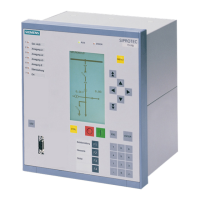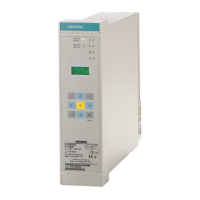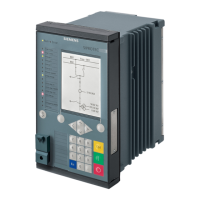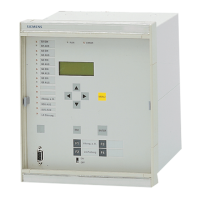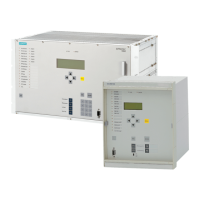Function Logic
Pickup Logic for the Entire Device
Phase Segregated Fault Detection
The fault detection logic combines the fault detection (pickup) signals of all protection functions. The protec-
tion functions that allow phase segregated pickup the output is done in a phase segregated manner. If a
protection function detects a ground fault, this is also output as a common device alarm. Thus the alarms
Relay PICKUP ØA
,
Relay PICKUP ØB
,
Relay PICKUP ØC
and
Relay PICKUP G
are available.
The above indications can be routed to LEDs or output relays. For some protection functions, also the picked
up phases are available as a group indication for displaying fault indications locally or transmitting them to a
PC or control center; only one group indication is displayed at a time and represents the entire pickup situa-
tion.
General Pickup
The pickup signals are combined with OR and lead to a general pickup of the device. It is signaled with the
alarm
Relay PICKUP
. If no protection function of the device has picked up any longer,
Relay PICKUP
disappears (message: “OFF”).
General device pickup is a precondition for a series of internal and external functions that occur subsequently.
The following internal functions are controlled by general device pickup:
•
Opening of fault case: From general device pickup to general device drop out, all fault messages are
entered in the trip log.
•
Initialization of fault storage: The storage and maintenance of fault values can also be made dependent
on the occurrence of a trip command.
•
Generation of spontaneous indications: Certain fault indications can be displayed as spontaneous indica-
tions (see margin heading “Spontaneous indications”). This indication can also be made dependent on
the general device trip.
•
Start action time of automatic reclosure (if available and used)
External functions may be controlled by this indication via an output contact. Examples are:
•
Automatic reclose devices,
•
Channel boost in conjunction with signal transmission by PLC,
•
Further additional devices or similar.
Spontaneous Indications
Spontaneous displays are fault messages which appear in the display automatically following a general fault
detection or trip command of the device. For the 7SD80, these messages include:
“Relay PICKUP.”:
protective function that picked up;
“S/E/F TRIP”: protection function which tripped (only device with
graphic display);
PU Time
:
Operating time from the general pickup to the
dropout of the device, in ms;
TRIP Time
:
the operating time from general pickup to the first
trip command of the device, in ms;
Tripping Logic for the Entire Device
3-Pole Tripping
The device trips 3-pole in the event of a fault. The output function
Relay TRIP
is used for to send the
command to the circuit breaker.
2.16
2.16.1
2.16.2
Functions
2.16 Function Logic
SIPROTEC 4, 7SD80, Manual 177
E50417-G1100-C474-A2, Edition 02.2018

